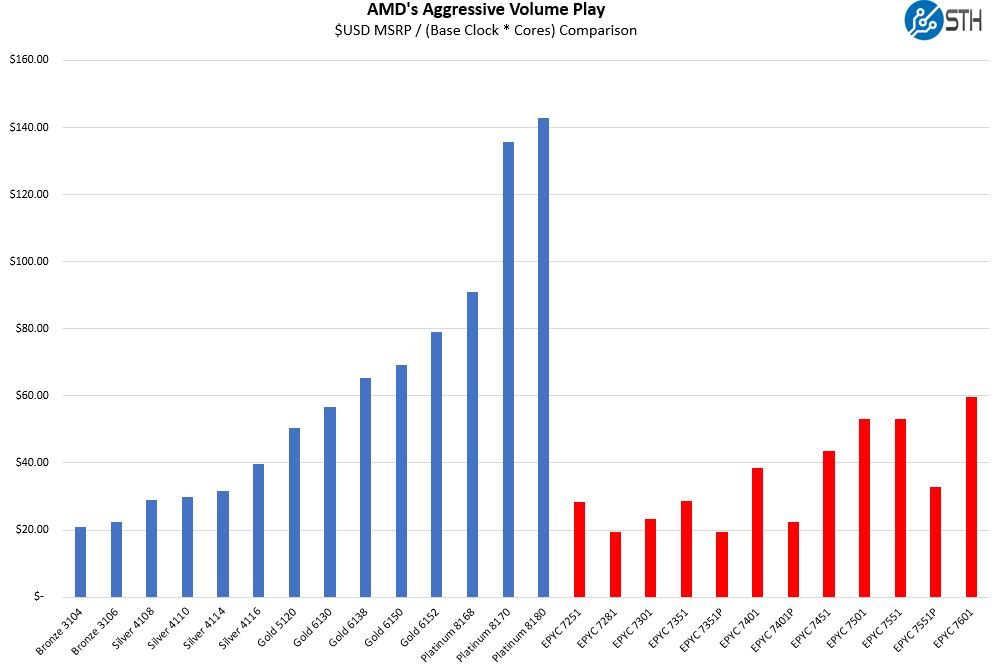AMD EPYC 7451 Power Consumption
The other side of the equation is power consumption. The AMD EPYC 7451 is putting up some impressive benchmark numbers, but that does have an associated cost. Here is what we saw on our PDU after a few runs:
- Idle: 79W
- 70% Load: 226W
- 100% Load: 271W
- Peak: 356W
Note these results were taken using a 208V Schneider Electric / APC PDU at 17.8C and 71% RH. Our testing window shown here had a +/- 0.3C and +/- 2% RH variance. The figures are certainly more than the Intel Xeon Silver line, but with that extra power consumption, AMD is delivering a more expandable platform and more performance.
AMD EPYC 7451 Market Positioning
AMD has a number of competitive vectors. The obvious competition is the Intel Xeon Scalable line. AMD also has P series parts that compete in this market.
AMD EPYC 7451 v. Intel Xeon
Performance wise, the AMD EPYC 7451 single CPU is competitive with either a dual Intel Xeon Silver 4116 or single socket Intel Xeon 6152 CPUs. There are workloads that favor AMD. There are others that favor Intel. Still, AMD is competitive and if you are in a per-socket licensing model, for example with VMware, AMD has additional cost savings that can be realized. Even without taking advantage of single-socket only SKUs, the AMD EPYC per-core pricing is still extremely competitive against Intel’s offerings. If you are in a per-core licensing regime, then Intel has a number of core/ frequency optimized CPUs that are designed to minimize license costs.

If you want to look at what AMD is doing in terms of single socket pricing, across its line and with respect to Intel, check out AMD EPYC’s Extraordinarily Aggressive Single Socket Mainstream Pricing.
AMD EPYC 7451 v. AMD EPYC
The AMD EPYC 7451 is in the market alongside offerings from Intel, but also other AMD EPYC 7000 series offerings. AMD has single-socket specific parts denoted with “P” in the model numbers that are single socket only parts. If we were looking at a dual socket configuration, these P parts are not in play. Therefore, if you are looking at these benchmarks deciding between dual socket EPYC 7000 series configurations, those P parts are not in play.
If we were spec’ing a single socket only server, we would likely suggest the AMD EPYC 7401P at 24 cores and lower clocks, but around half the price. Alternatively, at a similar price, you can get an AMD EPYC 7551P with 32 cores and 64 threads, albeit limited to single socket only configurations.
Final Words
The real value proposition of the AMD EPYC 7451 is in dual socket configurations. Otherwise, the pricing attractiveness of the AMD EPYC “P” parts is too attractive to ignore. At the same time, the performance speaks for itself. In this article, we clearly showed how AMD can be competitive with a single socket midrange part against two Intel Xeon Silver 4116 “top of the Silver line” CPUs. We also showed that AMD single socket to single socket performance can match well against the Intel Xeon Gold 6152 SKU at half the cost.
At the end of the day, AMD is making solid chips. If you want an alternative to Intel in the enterprise, despite the POWER / ARM player’s best efforts, AMD EPYC 7000 series is the only viable alternative at this point. Not only is it a viable alternative, but it performs well, it has more expansion capability, and it is less expensive. More importantly, it will run Windows Server 2016, VMware and other enterprise platforms out of the box. It can be used for VDI deployments out of the box. There is something to be said for x86 compatibility as the x86 instruction set has decades of enterprise software compiled and optimized for it. Here, AMD EPYC 7000 series is a viable competitor.




Great review. this Epyc’s doing truly epic work. The value’s incredible.
In future, could you please include the exact X-axis benchmark values in the bars though? Something like; https://i.imgur.com/TdL6UhR.png Just to have exact data and make it easier to compare instead of guesstimating based on the numbers at the bottom.
Cheers.
It would be great to get some FFMPEG benchmarks!